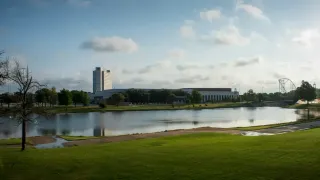August 13, 2017
Q&A: Sasha Sommers Lights Up the World
Scott Holland READ TIME: 3 MIN.
Q: Tell us about the first time you saw a drag performance? What was the experience like?
A: The first drag show I ever saw was at the Warehouse 2 in Nashville Tenn., and it starred Bianca Page, Rita Ross, Stephanie Wells, Vanessa Del Rio, and Diana Hutton. I was completely mesmerized! It was definitely a wow factor to me - not so much that I looked at them and wanted to do it, or thought I could do it, but honestly it was captivating. Looking back [I was like] a teenager at their first concert! It was like seeing a very good movie, and when you leave the theater you want to get back in line and buy another ticker to the same show!
Q: When did you decide you wanted to do drag and when did you realize it would be a profession?
A: The decision was mine, but for me doing drag professionally happened by sheer chance. I had entered a weekly talent contest, more so for fun...and won with a drag performance! Feeling on top of the world, I went home and got together a new costume and returned the next week and won again! Each week I learned and improved a little from the week before, and 17 weeks in a row I won! The owner of the club finally came to me and said (in a dressing room full of people), 'You have won our contest 17 weeks in a row, congrats! We are proud of you, but you can't do the contest anymore, at least for a while.' I literally felt like I lost my best friend. He continued, 'You can't do the contest anymore, because we want to offer you a cast position... would you be interested?' That night is when it became a profession/career.
Q: Who is your drag mother and who is your favorite queen other than your drag mother and why?
A: My drag mother is Ciji Dunne, and one of my favorites is Dena Cass. I have always looked up to Dena. I have admired her style of drag, her costumes, her ability to capture and keep the attention of any crowd. For those of you who don't know Dena, she is also a plus-sized entertainer, and has won many nationals titles.
Q: What's your favorite number to perform and why?
A: I have never really had a favorite number to perform, however, I have several requested numbers that people like to see me perform, and I enjoy doing them.
Q: What's the best thing that has happened to you in drag?
A: I would have to say the best thing to happen to me in drag would be the fact that people look up to you and admire you. Having drag fans and friends is one thing, but when there are actually people who like you and appreciate what you do, it really means a lot!
Q: What differentiates you from other queens. What makes you unique?
A: I don't know that there is any one thing that makes me unique. I have been an emcee for many events and pageants, and have been told many times I should have been a comedian. I have captured many audiences with certain performances and to give other girls their credit... several girls have done the same thing for me. I guess what makes me unique is my style and the twist I put on things.
Q: What does the future hold?
A: All of us at one time or another have been dealt a rough hand in life. 2016 was the absolute worst year of my life! Twice in that year my time on earth came extremely close to expiring. I had a heart attack on Easter Sunday, and later on that year nearly had a limb amputated. I am not letting this be known for any type of sympathy. What I am doing is letting people know that no one knows their future. I can say I am truly blessed to still be able to wake up every day, and with two feet. I have done things in life that I am not very proud of, I am no angel. I also know I have done some great things for people and our community. I have always tried to help when I can and be there for others. I believe in my situation, my good outweighs my bad. I have been given the opportunity to stay here and wake up every day, and for now...that's my future!
Why We Love Her
She is one of the best MC's around
She is always there to give back to her sisters.
She is a fighter, and battled back from two very serious illnesses
When she smiles, the world lights up!
 Copyright HotSpots! Magazine. For more articles from HotSpots! visit
Copyright HotSpots! Magazine. For more articles from HotSpots! visit 





